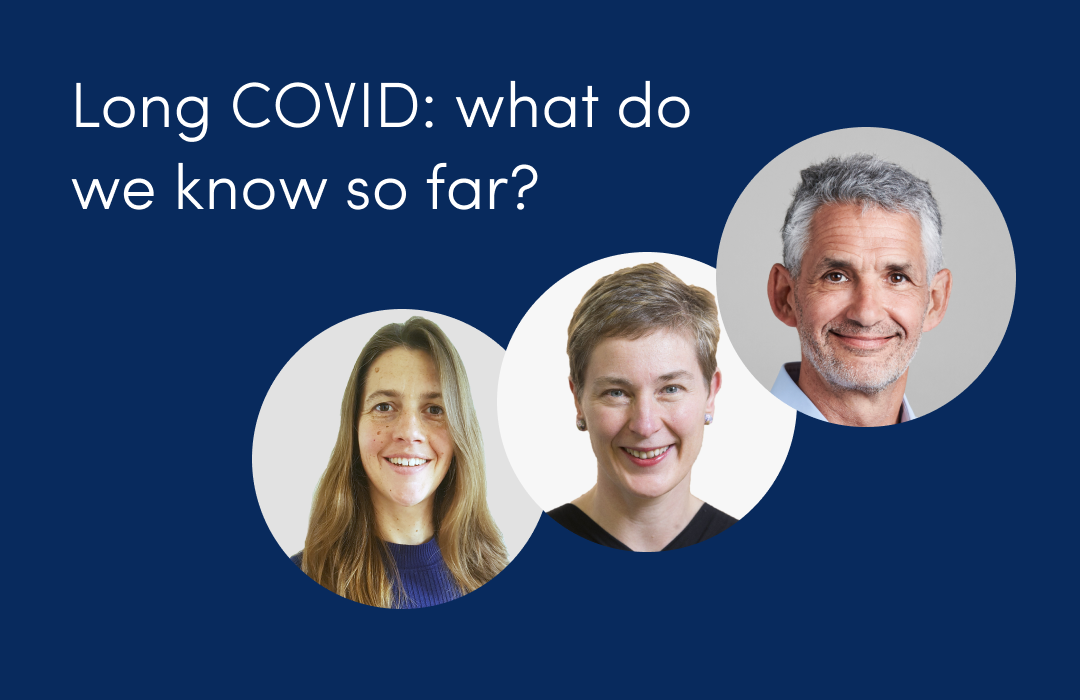.png)
What does Omicron mean for the future of COVID?
February 4, 2022

This article has not been updated recently
- What is the Omicron variant and how common is it?
- Why does Omicron spread so quickly?
- How will we identify new variants in the future?
- What is the ‘stealth variant’?
- Does Omicron cause different symptoms?
- Why can you still get Omicron if you’ve been vaccinated?
- What does Omicron tell us about the future of COVID?
In our latest expert webinar, Professor Tim Spector, lead scientist at the ZOE COVID Study, was joined by Professor Wendy Barclay, Head of Infectious Diseases at Imperial College London.
They answered your questions on why Omicron quickly became the dominant strain in the UK, how effective vaccines are against it, whether it really is more mild and what this means for the future of the COVID pandemic.
What is the Omicron variant and how common is it?
Omicron is a version of the SARS-CoV-2 coronavirus that causes COVID-19, and was first detected in South Africa in November 2021. The Omicron variant has mutations that make it spread very quickly, including between people who have previously had a COVID infection or are vaccinated.
Due to its highly transmissible nature, Omicron has swept rapidly across many countries, and it is now the most prevalent variant in the UK. Data from the latest REACT survey found that in the first few weeks of January 2022, 99% of COVID infections in the UK were caused by Omicron with more than one in 20 people infected with the variant.
“If you currently have COVID, it’s almost certainly Omicron”, says Tim.
When the number of cases started to fall in mid-January, we hoped that the peak of Omicron had passed, but the latest data from the ZOE COVID Study shows that this decline was short lived and numbers of infections are creeping up again. “Looks like we’re stuck with Omicron for a while longer,” adds Tim.
Omicron is also growing in prevalence in other countries, such as the US, Denmark and India. “Wherever you look, Omicron is displacing previous variants - such as Delta - and becoming the dominant strain,” Wendy explains.
Why does Omicron spread so quickly?
Its high transmissibility means that Omicron has quickly outcompeted Delta to be the most common variant in the UK. And thanks to more than 30 mutations in the spike protein, Omicron has changed the way the COVID virus appears to our immune system.
“In a partially immune or totally immune population, Omicron has the edge” explains Wendy.
“That means the antibodies we made in response to previous infections or a vaccination don’t ‘see’ Omicron as well as Delta and previous variants” she adds.
The increase in numbers we’re seeing are the result of Omicron being able to transmit really well between more people - unvaccinated, vaccinated and people who’ve previously had COVID - plus its ability to escape immunity.
“It’s a double whammy,” says Wendy.
How will we identify new variants in the future?
We need a combination of different kinds of tests, surveys and monitoring to keep on top of COVID and the government will continue to look out for new variants.
“PCR tests have been incredibly useful in tracking the emergence of variants” says Wendy.
When you have a PCR test, your sample goes through three separate PCR reactions in the lab - each looking for a different bit of COVID genetic make-up. For Omicron, one of the three reactions shows up negative. If a new variant has changes in their genetic makeup, the PCR test is able to show COVID is present and give an early indication that it’s different.
“Omicron was picked up in this way and its spread across the UK monitored via PCR tests,” she adds.
By monitoring symptoms across hundreds of thousands of people, the ZOE COVID Study can also quickly pick up anything unusual spreading through the population. It’s important that everyone keeps logging daily health reports in the app to contribute to monitoring the impact of emerging variants.
What is the ‘stealth variant’?
The so-called ‘stealth variant’ - more formally known as BA.2 - is a subtype of Omicron. Cases caused by BA.2 are doubling in the UK every few days.
Omicron can be split into three sub-lineages or types called BA.1, BA.2 and BA.3. “These three types all came from the same place but at some point diverged into three slightly different flavours of Omicron,” describes Wendy.
We’re still learning about how BA.2 behaves, but it seems to have a slight advantage over BA.1 when both are present in the same population of people. We know BA.2 has the same properties of being a great transmitter and escaping the immune system, and work is underway to understand its biology.
“It can be concerning when something new comes along and we don’t know much about it,” says Tim. “However, there’s some good news from Denmark, where the BA.2 subtype of Omicron hasn’t changed hospital admission rates. I don’t think we’re seeing more death or more severe disease.”
Does Omicron cause different symptoms?
Data from the ZOE COVID Study shows that there are differences in the symptoms caused by Omicron compared with previous variants.
Moving from Delta to Omicron, people seem to be experiencing fewer of the three classic symptoms (cough, fever and loss of smell) and getting more cold-like symptoms such as a sore throat. We’re still investigating what the increase in reports of gastrointestinal symptoms like diarrhoea, skipped meals and abdominal pain, which were prevalent with previous variants, means now since the increase doesn’t appear to be linked with those who test positive for Omicron.
“Even with millions of people reporting their daily symptoms with ZOE, it’s hard to measure the shifting symptoms”, explains Tim.
It’s not necessarily true to say the symptoms caused by Omicron are more mild than with previous variants. The majority of the UK population is now double or triple vaccinated, as are most of the contributors to the ZOE app, which has a strongly protective effect against severe illness and hospitalisation. Many people have also previously had COVID, providing a certain amount of protection (although less than vaccination), which all adds up to a higher base level of immunity than we’ve had in previous waves.
Our latest data is also beginning to show Omicron infections don’t last as long as Delta. “One in three people with Omicron will recover within three days compared to around one in six with Delta”, Tim says.
But, as Wendy points out, this higher level of population immunity doesn’t guarantee that everyone is safe from the virus.
“It’s important to remember that as the amount of Omicron out there increases, then more vulnerable people may get it, and therefore we may see more people having to go to hospital,” she adds.
Why can you still get Omicron if you’ve been vaccinated?
Omicron is causing high rates of infection and many people who have previously had COVID are catching it again, due to the way in which the virus is evolving.
“With earlier variants, there was a very good match between the COVID virus and the vaccines, so the vaccine could help prevent infection as well as disease. Gradually - as variants change more and more - vaccines still prevent severe disease but don’t prevent infection as effectively,” explains Wendy. “Furthermore, variants do not emerge in a linear way, and the two variants that are the most different from each other are Delta and Omicron.”
This means that even if you were infected by Delta and are still unvaccinated, you aren't very well protected from Omicron.
In the future, we’ll need to develop vaccines that have the best chance of working against as many emerging variants as possible. However, vaccination still provides better protection against possible future variants than natural immunity alone.
“Vaccination broadens out your immune response and gives you potentially better protection against all the other variants that will come along later,” Wendy adds.
What does Omicron tell us about the future of COVID?
As we learn more about Omicron, there may be changes in how we use vaccines and boosters to best protect the population. This might mean we need vaccines that help prevent recurring infections so people don’t have to keep taking time off work or miss school.
If Omicron causes a relatively mild infection in most people, especially those who have already had three or four doses of the current vaccines, it becomes important for us to better identify who needs boosters and updated vaccines.
“The next big discussions will be around where we go in terms of protecting future vulnerable people” says Wendy.
Researchers are working hard on the current unknowns, such as how might the virus mutate next and whether antigenic escape - the ability of new variants to avoid our immune system - is driving milder infections.
“This won't be the last variant we see and we don’t know the characteristics of future ones”, Wendy says. “But thanks to the great uptake of vaccines, we have a good level of base immunity among the public and there’s evidence that even for an antigenic escape variant like Omicron being vaccinated reduces the risk of severe disease, hospitalisation and death.”
The ZOE COVID Study remains an essential tool used by the government and researchers to help track the pandemic and new variants as they emerge. You can play your part in the world’s largest COVID study by downloading the ZOE COVID Study app and logging daily health reports.
Stay safe and keep logging!














.jpg)














.png)







%202.png)
.png)


















.png)




%20(1).png)


